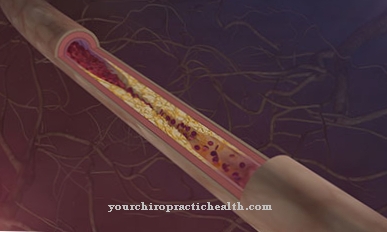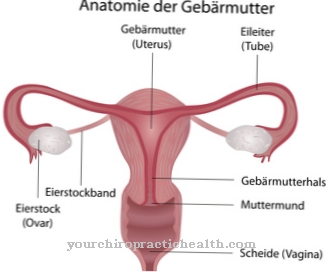The Verma-Naumoff Syndrome belongs to a group of congenital diseases that are characterized by malformations of bone and cartilage tissue. The prognosis for the disease is always fatal. The syndrome is genetic and is inherited as an autosomal recessive trait.
What is Verma-Naumoff Syndrome?
The Verma-Naumoff Syndrome is a genetic disease of the bone and cartilage tissue. It is characterized by a large number of malformations on internal and external organs. The course of the disease is always fatal. The multitude of malformations is incompatible with life. The syndrome can be diagnosed prenatally by sonography. The child is either born still or dies immediately after birth due to the many dysplasias.
By definition, the disease belongs to the group of congenital osteochondrodysplasias. This is a group of genetic diseases that are characterized by dysplasias (malformations) in the bone and cartilage tissue. Within these diseases, the Verma-Naumoff syndrome is counted among the so-called short-rib polydactyly syndromes. As the name suggests, these syndromes are characterized by short ribs, underdeveloped lungs, and multiple fingers (polydactyly).
The constricted thorax is noticeable through insufficient lung function. The syndrome was first described in 1974 by the Mainz pediatrician J. Spranger. However, he did not yet differentiate it from similar forms of disease. Only I. C. Verma (1975) and P. Naumoff (1977) differentiated the syndrome from short-rib polydactyly syndrome type I (Saldino-Noonan syndrome).
Since then, it has been referred to as short-rib polydactyly syndrome type III or Verma-Naumoff syndrome according to the international classification. According to morphological-radiological criteria, a further classification into short-rib polydactyly syndrome II type Verma-Naumoff was made.
causes
The only known cause of Verma-Naumoff syndrome is that it is a genetic disorder that is inherited as an autosomal recessive trait. Many other congenital chondrodystrophies are caused by gene mutations in a specific area of chromosome 4. It is therefore reasonable to assume that there are also mutations in this section in Verma-Naumoff syndrome.
It is not known whether only one gene is affected or whether several mutated genes cause similar symptoms. In any case, an autosomal recessive inheritance was found, but this does not have to be restricted to just one gene. In similar diseases, such as Ellis-van-Creveld syndrome, at least two adjacent genes have been discovered that can lead to the same disorder.
After the autosomal recessive inheritance, the disease can only occur if both parents have the mutated gene heterozygous in their genetic makeup. However, there is no information about the frequency of the disease. There may be a larger number of unreported cases due to miscarriages.
Symptoms, ailments & signs
The symptoms of Verma-Naumoff syndrome are varied. Like all short-rib polydactyly syndromes, it is characterized by short ribs with thoracic hypoplasia, underactive lung and respiratory failure. There is also dysplasia of the long bones and often polydactyly (many fingers).
In addition, the Verma-Naumoff syndrome is often associated with hydrops (dropsy), which causes water to accumulate in the chest. Furthermore, weak breathing is a key symptom of the disease. Polydactyly does not always occur. It only occurs 50 percent of the time. Other symptoms are closely related to the complex heart defects. A short bowel is also characteristic. In addition, there is a disturbance in the rotation of the small intestine and large intestine, which is known as malrotation.
This malrotation can lead to an intestinal obstruction. Another characteristic is anal atresia. Here the rectum is malformed, whereby the opening to the anal pit is missing. Urethral atresia is also observed. In this case, the opening at the end of the urethra is missing. The kidney is often underdeveloped or not functional at all. Furthermore, deformities also occur in the genitals. A cleft lip and palate (cheilognathopalatoschisis) can also occur.
The epiglottis (larynx lid) often shows malformations. There is also an esophageal atresia. Either there is no connection between the esophagus and the stomach or the esophagus is narrowed. It is also possible that the esophagus is connected to the trachea instead of the stomach. Overall, the malformations are so serious that the child has no chance of survival.
Diagnosis & course of disease
Verma-Naumoff syndrome can be diagnosed in the womb. The x-ray shows short ribs. Compared to Saldino-Noonan syndrome, the long bones are jagged at the end and not as shortened. The diagnosis can be made by sonography alone. Other imaging methods such as CT and MRI can confirm the diagnosis.
Complications
The Verma-Naumoff syndrome primarily causes breathing problems. Respiratory insufficiency occurs, so that the internal organs are no longer supplied with sufficient oxygen. This can cause the skin to turn blue.
If the disease is not treated, the internal organs and the brain can be permanently damaged. Furthermore, various heart defects occur, which in the worst case can lead to the death of the person concerned. There are also discomforts in the small intestine and the large intestine, so that those affected often suffer from pain or diarrhea. Intestinal obstruction is also common among those affected.
Since the kidneys can also be affected by malformations, those affected need a transplant or are dependent on dialysis. There are also various malformations on the body that make everyday life much more difficult for those affected. As a rule, the child dies a few days after birth and cannot survive. Verma-Naumoff syndrome can also lead to severe psychological complaints and depression in parents or relatives. They are therefore dependent on psychological treatment.
When should you go to the doctor?
With Verma-Naumoff syndrome, the person concerned is always dependent on treatment by a doctor. Since this disease cannot heal itself, a doctor should always be contacted at the first symptoms and signs of the syndrome. The earlier the disease is recognized and treated by a doctor, the better the further course will usually be.
A doctor should be contacted if the person concerned has a breathing problem. Not enough air enters the lungs, causing the patient to cough. In many cases, this also turns the skin blue, and some people may even lose consciousness. Heart defects also indicate the Verma-Naumoff syndrome. Those affected also suffer from deformities of the face or head, which can also indicate this disease.
Verma-Naumoff syndrome can be detected by a pediatrician or a general practitioner. Further treatment depends on the exact type and severity of the complaints, so that no general prediction can be made. In many cases, this syndrome reduces the life expectancy of those affected.
Therapy & Treatment
There is no therapy option for Verma-Naumoff syndrome. The course of the disease is 100 percent lethal. Often the child is born dead or dies shortly after birth. In the group of osteochondrodysplasias, however, there are also diseases that are not curable, but at least offer a chance of survival.
With every syndrome, the symptoms are sometimes variable. It is currently not known whether there are different forms of the Verma-Naumoff syndrome in which there is also a chance of survival.
prevention
It is not possible to prevent Verma-Naumoff syndrome. The syndrome is a genetic disorder that is inherited as an autosomal recessive trait. Therefore, a spontaneous occurrence of the disease is very unlikely. For the syndrome to break out, both parents must have the mutated gene. If one or more cases of illness have already occurred in the family, genetic counseling should be sought.
Aftercare
As a rule, those affected with Verma-Naumoff syndrome have only very few and only very limited direct follow-up measures available, so that with this disease a doctor should primarily be consulted as early as possible so that it does not occur later complications or other complaints arise. As a rule, it cannot heal itself, so ideally a doctor should be contacted as soon as the first symptoms and signs of this disease appear.
Since this disease is inherited, it cannot be completely cured. Therefore, if the person concerned wishes to have children, he or she should seek genetic testing and counseling in order to prevent the disease from recurring in the descendants.
In general, those affected depend on the help and support of their own family in everyday life. Loving and intensive conversations can have a very positive effect on the further course and prevent the development of depression and other psychological upsets. Verma-Naumoff syndrome may reduce the life expectancy of those affected.
You can do that yourself
Verma-Naumoff syndrome cannot yet be treated. The child dies before or during the birth due to various malformations. The child's parents can use talk therapy to help deal with the trauma. Self-help groups and forums on the net are suitable contact points to talk to other affected persons.
A visit to a specialist center for hereditary diseases is also an option. The better the disease is understood, the easier it is to cope with a severe course. In addition, the usual measures apply after the birth.
Sexual intercourse should be avoided until the weekly flow stops. During the first few days, care must be taken to ensure that there are no infections in the vaginal tract. In addition, the bandage should be changed frequently to avoid inflammation of the perineal incision scar. Pelvic floor exercises stimulate blood flow to the pelvic floor area, which makes recovery faster.
Finally, a healthy diet with sufficient proteins, vitamins and plenty of fluids will help you recover. Sufficient rest and protection contribute to the healing process and ensure that the mother of a sick child can recover quickly despite the trauma.

.jpg)











.jpg)

.jpg)
.jpg)











.jpg)